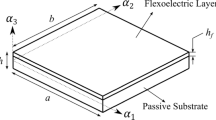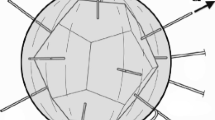Abstract
In the flexoelectric sensing element using the bending mode, the estimation of the flexoelectric coefficient was investigated using 3-D stress/strain analysis and experiments. The proposed method uses the results (deformation and strain) from the finite element analysis (FEA). The estimated flexoelectric coefficients were compared with those obtained via the conventional method (Euler’s beam theory) under the assumption of the quasi 1-D stress field. The results show that the RMS value and standard deviation of the estimated flexoelectric coefficient for the 3-D stress-field case of the sensing element are 31.51 µC/m and 0.24 %, respectively. In addition, it is found that the flexoelectric coefficient obtained from the results of the 3-D stress analysis is 1.8 % smaller than that of the quasi-1-D stress analysis. Therefore, in order to obtain a more reliable flexoelectric coefficient in the sensing element, the results of the 3-D numerical stress analysis should be used for accurate estimation of the flexoelectric coefficient.
Similar content being viewed by others
Abbreviations
- δ :
-
Displacement at the center tip of the element
- l x :
-
Length of the unimorph
- l y :
-
Thickness of the unimorph
- l z :
-
Half width of the unimorph
- q 0 :
-
Charge output
- P y :
-
Polarization in y direction
- μ 12 :
-
Transverse flexoelectric coefficient
References
S. M. Kogan, Piezoelectric effect during inhomogeneous deformation and acoustic scattering of carriers in crystals, Soviet Physics—Solid State [Translation of Fizika Tverdogo Tela (Leningrad)], 5(10) (1964) 2069–2070.
W. Huang, K. Kim, S. Zhang, F.-G. Yuan and X. Jiang, Scaling effect of flexoelectric (Ba,Sr)TiO3 microcantilevers, Physica Status Solidi Rapid Research Letters, 5(9) (2011) 350–352.
X. Jiang, W. Huang and S. Zhang, Flexoelectric nanogenerator: materials, structures and devices, Nano Energy, 2(6) (2013) 1079–1092.
S. R. Kwon, W. Huang, S. Zhang, F.-G. Yuan and X. Jiang, Study on a flexoelectric microphone using barium strontium titanate, Journal of Micromechanics and Microengineering, 26(4) (2016) 045001.
W. Huang, S. R. Kwon, F.-G. Yuan, S. Zhang and X. Jiang, A flexoelectric micro-accelerometer, ASME 2012 International Mechanical Engineering Congress and Exposition, American Society of Mechanical Engineers (2012) 597–603.
S. R. Kwon, W. Huang, S. Zhang, F. G. Yuan and X. Jiang, Study on a flexoelectric microphone using barium strontium titanate, Journal of Micromechanics and Microengineering, 26(4) (2016) 045001.
W. Huang, X. Yan, S. R. Kwon, S. Zhang, F.-G. Yuan and X. Jiang, Flexoelectric strain gradient detection using Ba 0.64 Sr 0.36 TiO3 for sensing, Applied Physics Letters, 101(25) (2012) 252903.
S. R. Kwon, W. Huang, S. Zhang, F.-G. Yuan and X. Jiang, Flexoelectric sensing using a multilayered barium strontium titanate structure, Smart Materials and Structures, 22(11) (2013) 115017.
S. R. Kwon, A study on the flexoelectric coefficient in the frustum pyramid sensing element with the rigid laminates at the upper and bottom surfaces, Transactions of the Korean Society of Mechanical Engineers, 44(1) (2020) 1–6.
W. Ma and L. E. Cross, Flexoelectric polarization of barium strontium titanate in the paraelectric state, Applied Physics Letters, 81(18) (2002) 3440–3442.
B. Chu, W. Zhu, N. Li and L. Eric Cross, Flexure mode flexoelectric piezoelectric composites, Journal of Applied Physics, 106(10) (2009) 104109.
W. Ma and L. E. Cross, Flexoelectric effect in ceramic lead zirconate titanate, Applied Physics Letters, 86(7) (2005) 072905.
W. Ma and L. E. Cross, Flexoelectricity of barium titanate, Applied Physics Letters, 88(23) (2006) 232902.
W. Ma and L. E. Cross, Observation of the flexoelectric effect in relaxor Pb(Mg1/3Nb2/3)O3 ceramics, Applied Physics Letters, 78(19) (2001) 2920–2921.
W. Zhu, J. Y. Fu, N. Li and L. Cross, Piezoelectric composite based on the enhanced flexoelectric effects, Applied Physics Letters, 89(19) (2006) 192904.
S. R. Kwon, Study on the flexoelectric characteristics in the sensing element of a duplex frustum pyramid, Journal of Mechanical Science and Technology, 32(12) (2018) 5839–5843.
Acknowledgments
This work was supported by Basic Science Research Program through the National Research Foundation of Korea (NRF) funded by the Ministry of Science, ICT & Future Planning (NRF-2017R1A2B4009049).
Author information
Authors and Affiliations
Corresponding author
Additional information
Seol ryung Kwon received the Ph.D. degree in mechanical engineering from North Carolina State University in 2014. Currently, she is a senior researcher in Korea Institute for Robot Advancement, Daegu, Korea. Her major research interests include design and fabrication of flexoelectric sensors, mechatronics and micro manufacturing and standardization for intelligent robots.
Yongrae Roh received his B.S. and M.S. degrees from Seoul National University, Korea, in 1984 and 1986, respectively. He got his Ph.D. degree in Engineering Science and Mechanics from the Pennsylvania State University, USA, in 1990. From 1990 to 1994, he worked in the Research Institute of Industrial Science & Technology, Korea, as a senior research scientist. He joined Kyungpook National University, Korea, in 1994 and now is a Professor in the School of Mechanical Engineering. His major research area includes development of piezoelectric devices, medical ultrasonic transducers, and acoustic transducers for underwater SONAR systems.
Rights and permissions
About this article
Cite this article
Kwon, S.R., Roh, Y. A study on a new method for flexoelectric coefficient estimation of the flexoelectric unimorph sensing element. J Mech Sci Technol 36, 2259–2263 (2022). https://doi.org/10.1007/s12206-022-0408-z
Received:
Revised:
Accepted:
Published:
Issue Date:
DOI: https://doi.org/10.1007/s12206-022-0408-z




